Gray's Reef National Marine Sanctuary Sediment Characterization Assessment and Regional Development Cruise
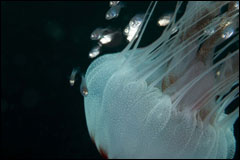 |
| Jelly with Fish. |
On May 27, 2006, the NOAA Ship NANCY FOSTER sailed south from Charleston Harbor (South Carolina) to embark on a two week mission to explore waters off the Georgia Coast. The ship was bound for Gray’s Reef National Marine Sanctuary (GRNMS) carrying 14 scientists from 6 agencies and institutions. Their mission: to conduct research operations around the clock, designed to gather information that will help managers better understand and protect the unique resources of this special area.
During their two weeks at sea, and with the help of cooperative weather and excellent underwater visibility, the group gathered quantities of data that will take many months to sort through…
During the 14 day operation, several projects were underway at all times. Each of these is described below, along with some preliminary results.
Habitat Characterization
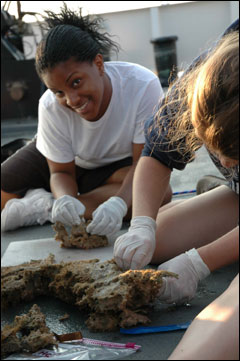 |
| Jade and Leslie taking samples from dead sponge. |
One of the primary goals of the mission was to help characterize the sediment and rock layers that are found within the sanctuary and surrounding areas to help understand the geologic history of the area. Led by scientists from Coastal Carolina College and Skidaway Institute of Oceanography the ship was used to map subsurface layers in the seafloor. To do this, scientists towed seismic instruments behind the NANCY FOSTER while the officers drove the ship along pre-determined track lines. These instruments, one called a sub-bottom profiler and the other a side-scanning sonar, emit sounds which, when reflected back to the instruments, provide information on the sediment layers below. The sub-bottom profiler provides information on rock formations and strata that are below the sand and and the side-scanning sonar give information on areas that lie above the sand. Looking at the data from these instruments tells scientists something about how those layers were formed and provides indications of how they may change over time. This work, undertaken during the first portion of the cruise (May 27-June 3), occurred at night, and the team mapped three north-south lines within the sanctuary. Unfortunately, equipment problems prevented the team from mapping the entire area, therefore more work will follow at a later date in order to fully characterize the geologic strata.
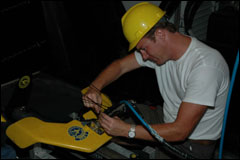 |
| Jamie Phillips prepares sidescan for launch |
Additional mapping activities conducted during the cruise collected valuable habitat information. This past winter, the NANCY FOSTER had a multibeam system installed on the ship. This system utilizes sound, like the sidescan sonar and sub-bottom profiler, to give scientists information about the seafloor. The difference is that in the case of multibeam, the data generated are of the difference in depth (bathymetry) from the multibeam sensor to the sea floor but it does not include the subsurface layers. Unlike side-scan data, the multibeam will not indicate where there are potential ledges but only where there are differences in depth. During the cruise, scientists collected multibeam data at a site outside the sanctuary boundary (called J-Reef) that is used as a control site because it is considered to be representative of biology and geology of Gray’s Reef. Prior to this mission, scientists did not have an accurate map of the area, so these data will provide much-needed habitat information for J-Reef.
Invertebrate Characterization
The second project undertaken during the cruise was coordinated by scientists from the South Carolina Department of Natural Resources’ Southeastern Regional Taxonomic Center (SERTC). The SERTC team is building a collection of invertebrates from the South Atlantic Bight (Cape Hatteras, North Carolina to Cape Canaveral, Florida). The collection serves as a tissue repository for genetic research and provides voucher specimens for development of taxonomic guides and digital images of specimens to document features that are not available in traditionally preserved material. Material obtained during the cruise will significantly augment this collection with specimens from the sanctuary and the surrounding area where the group had been unable to sample in the past.
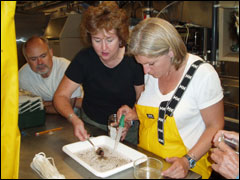 |
| Greg looking on as Betty and Susan process sample. |
Samples of plankton and bottom invertebrates within and near the boundaries of GRNMS were collected using a variety of gear types. Plankton collections were made at the surface using a neuston net at depth and in mid-water using a bongo net. Samples of bottom invertebrates outside the sanctuary boundaries were collected using a 20-ft. bottom scallop trawl. A 30-cm diameter Cape Town Dredge was deployed, however trawl gear proved to be more efficient for collections so use of the dredge was discontinued after a couple of tows. Plankton collections were made either one hour after sunset or one hour before sunrise. Trawling operations occurred during the daylight hours. Diving operations were completed daily and involved collection of specimens and underwater photos.
Plankton collections revealed a large number of crab megalopae, zoeae, as well as pelagic isopods and amphipods. Scyphozoans were most frequently observed in bongo tows. Plankton collections were made inside the Sanctuary as well as within 2 nautical miles of the border.
Trawl collections yielded different species composition depending on area sampled. Collections made in the vicinity of J Reef, an area of newly established bare reef substrata, yielded low diversity with sand dollars as the dominant species. A few sponges, echinoderms Luidia and Astropecten and turkey wing oysters were also collected.
Collections made along the southern boundary of Gray’s Reef revealed high diversity of sessile invertebrates and associated epifauna. Collections were dominated by ascidians and sponges. Sea urchins, decapods crustaceans, bivalves and gastropods were also collected in large numbers. A high diversity of sponges, including Ircinia and Speciospongia, were collected. Cryptic invertebrates associated with sponges and “live rock” were numerous and included tube worms, brittle stars, crabs, snapping shrimp, stomatopods, basket stars and octopus. Numerous trawl tows were made in this area.
Many of the specimens collected were photographed while alive, to provide high quality images for taxonomic guides, educational posters and the SERTC website. Specimens retained during the cruise were preserved, curated and cataloged for use by SCDNR, other researchers, graduate students, academic institutions, museums and various education programs.
Visual Fish Censuses
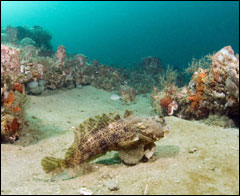 |
| Oyster toadfish on sand. |
A third project underway during the NANCY FOSTER cruise was Reef Environmental Education Foundation (REEF) fish surveys. These surveys involved two activities: roving diver fish counts and fish size surveys. Three divers dedicated themselves to this project and conducted visual censuses for the assessment of reef-associated fishes. While at sea, the three REEF divers conducted 25 roving REEF surveys and 39 size surveys at twenty one sites in and around Gray’s Reef. These data will be evaluated as a part of ongoing REEF efforts in GRNMS.
Photo Documenting GRNMS and Surrounding Waters
Divers from GRNMS collected video and still images in and around the sanctuary to collect in-situ video and still photographs of organisms inhabiting the reef. Toward this end, 74 dives were conducted, with video being completed at 19 sites and still photographs taken at 11 sites. Ten new sites were explored and photo documented. In all, over five hours of video were collected and hundreds of photographs were taken and are being cataloged.
Invertebrate & Fish Guide
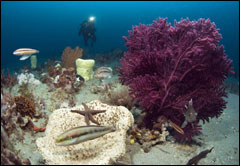 |
| Reefscape. |
Scientists from Georgia Southern University (GSU) conducted diving operations that is part of ongoing work to identify the benthic invertebrates and cryptic fishes of GRNMS and surrounding hard bottom areas. The group has developed “An interactive web-based guide to the benthic invertebrates and cryptic fishes of Gray’s Reef” (see website below). Their project includes identifying potential exotics, providing literature associated with species and building a database of phonological events and physical conditions of the reef. During the cruise they attempted to fill in gaps in the guide by targeting species where the database is lacking either photographs or specimens. They also collected in situ photography of conspicuous benthic macroinvertebrates that are not presently represented in the collection to expand the breadth of the web-based guide. Divers also explored a new site looking for new benthic organisms for the collection.
When not collecting data for the invertebrate and fish guide, the team continued meiofaunal sampling in hard bottom areas by vacuuming them up with diver operated suction dredges and by suspending buffer pads slightly above the reef substrate. They also collected and redeployed PVC traps for assessments of cryptic fish and invertebrate fauna. There are ten traps on three different reefs that are collected at periodic intervals. Finally, divers redeployed temperature probes on three different reefs to document spatial variation in the temperature profile directly on the reef substrate.
Invertebrate Dispersal and Recruitment
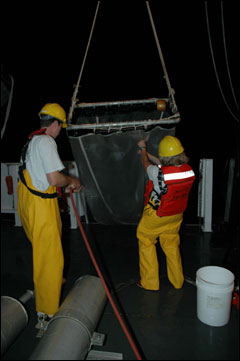 |
| Susan DeVictor and Pierce retrieving net. |
GSU scientists also investigated the dispersal and recruitment of benthic marine invertebrates at GRNMS. The specific goals of the project were to follow recruitment of benthic marine invertebrates to newly established patches of bare reef substrata off the coast of Georgia and document the changes in patch community structure over time. This project has practical implications for management of the GRNMS because it provides baseline information that can be used to assess what short and long-term impacts might result from user-induced damage to the benthos.
During the cruise, scientists continued to monitor the 20 plots established and 10 pieces of artificial substrate deployed at J-Reef in 2004. Divers also re-established treatment plots a the GRNMS monitoring site by scraping clean 30x30 cm sections of substrate on the top of the ledge. Ten haphazardly selected plots were scraped clean and 10 control plots were unmanipulated. At J-Reef, samples of Oculina were collected from a histocompatability experiment for growth experiments in aquaria back at the University’s lab.
Sponge Defense Mechanisms
Another project undertaken by Georgia Southern scientists involved looking at the inducible defenses in temperate reef sponges. The objective of this study was to determine if temperate marine sponges employ inducible chemical defenses to deter predation. To accomplish this objective, sponge tissue was collected. Samples were then placed in predator-exclusion cages or left uncaged to expose them to predators. After one week, the tissues were retrieved to analyze chemical defenses in each group.
Additional research on the chemical defenses of temperate reef sponges involved looking at the variation in chemical defenses and nutritional quality within the sponges. This project investigated the possible allocation of defensive compounds to susceptible or nutritious regions of three temperate reef sponges. Researchers used well-established methods to quantify the nutritional quality and concentration of defensive compounds in the inner and outer regions of three species of reef sponges.
Sponge Systematics & Photosybionts
One researcher from the University of Alabama at Birmingham participated in the cruise to investigate the systematics and photosymbionts of marine sponges. GRNMS harbors diverse sponge communities and represents a unique reef ecosystem, acting as a geographically isolated intermediate zone between the temperate Bermudan and tropical Caribbean reef flats. This geographic isolation and intermediate location may lead to accelerate speciation among sessile invertebrates, limited in their dispersal capabilities, and a unique sponge fauna.
Preliminary genetic analysis of sponges collected from Gray’s Reef and surrounding areas suggests several species may represent genetically-distinct cryptic species or subspecies, exhibiting morphological similarities to described species but distinct molecular signatures. During this cruise, researchers completed the collection of Gray’s Reef sponges, focusing on keratose species not seen/collected during previous efforts and an unidentified species.
This research also focuses on the association between sponges and photosynthetic symbionts. Similar to the coral-zooxanthellae association, marine sponges may rely on photosymbionts as a means of supplemental autotrophic nutrition in environments where heterotrophic filter-feeding is insufficient. Several common sponge species found at Gray’s Reef are know to harbor symbiotic cyanobacteria (e.g. Chondrilla nucula and Aplysina fulva) suggesting this association may be a factor in their ability to compete and survive. During the cruise, researchers surveyed the dominant Gray’s Reef sponge species for the presence and abundance of photosynthetic symbionts using chlorophyll a analysis.
Outreach
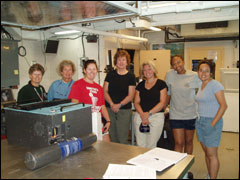 |
| REEF and SERTC crews. |
In order to spread the word of the incredible and productive efforts underway during this research cruise, a variety of activities were undertaken to highlight these activities. Members of the media were invited to visit the ship for a day. In addition, the Blackbeard Scuba, a Savannah area scuba club, was invited to visit the ship and learn about research efforts underway in the sanctuary. Project Oceanica, based at the College of Charleston, had representatives aboard the ship during the entire mission to photograph the activities and write information on what was being accomplished for the project’s website (see below).
Not surprisingly, the scientists returned to Savannah at the end of the mission exhausted but elated. A tremendous amount of information was gathered during the two-week effort. Scientists explored areas they had not seen before, gathered amazing photographs of the reef’s inhabitants, and added large quantities of data to collections and guides. It will likely take them until next year when the ship returns to process all this fantastic information. But they’ll be eager to hop aboard for another productive mission when it does!
CONTACT INFORMATION:
Greg McFall
Greg.McFall@noaa.gov
912-598-2416
graysreef.nos.noaa.gov
LINKS:
http://www.bio.georgiasouthern.edu/GR-inverts/
http://www.dnr.sc.gov/marine/sertc/
http://www.coastal.edu/cmws/
http://oceanica.cofc.edu/
http://www.reef.org/
|





